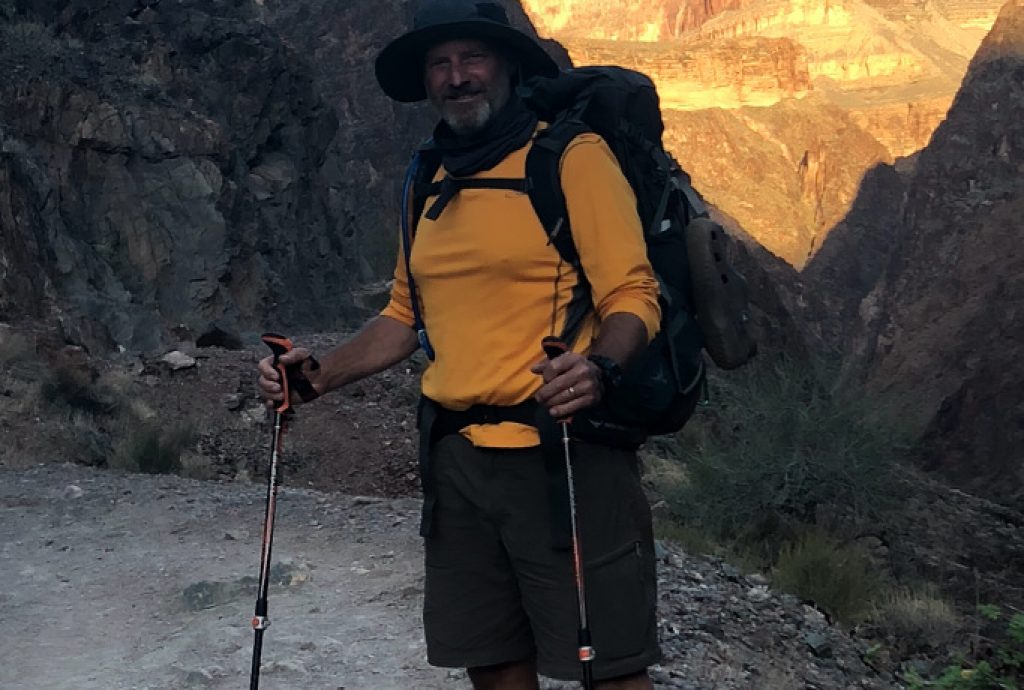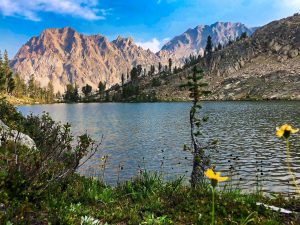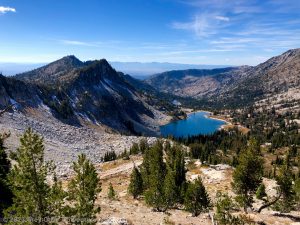
An overview of backpacking clothing and what to wear for a comfortable backpacking trip.
Chris & Mac
We outventure to help you outventure!
Support Grey Otter Outventures!
Please help us continue to bring you great content:
Preplanning – Check! Water, hydration, food – Check! Navigation, first aid, emergency supplies – Check! Now it’s time to examine backpacking clothing.
Backpacking Comfort
Be comfortable! Stay away from cotton, particularly blue jeans. Performance wear is the only way to go. Cotton clothing gets wet from sweat and stays wet. Performance wear pulls moisture from the skin and dries quickly. We’ll save you the gory details, but moisture on the skin while hiking makes for an uncomfortable experience.
Performance underwear and shirts will ensure your comfort on the trail in all conditions (remember, in the cold you will also sweat if you are hiking a trail that is rigorous FOR YOU). As far as hiking pants or shorts, they should also be moisture wicking and allow you to move freely. Freedom of movement is particularly important in long pants and you can easily find hiking appropriate pants in 2-way or 4-way stretch. None of this needs to be top dollar clothing, discounted performance wear can be found in many stores and online or on sale. Unless you are a fashionista, it doesn’t matter how you look (the animals don’t care), it matters that you are comfortable.
Socks
Buy yourself good hiking socks. It can be hard to get these inexpensively, by sock standards, but your feet will thank you. We particularly like merino wool socks because they cool your feet in the warmer months and keep them warm in the cooler months. Check around and read some reviews about your socks. Your feet and their happiness are critical to your enjoyment, so treat them well.
Hiking Shoes for Backpacking
Speaking of feet, let’s talk hiking shoes. There are a wide variety out there. When you are day hiking, you can generally get away with less support (although us older folk typically like greater support to compensate for aging feet, ankle, and knees). For backpacking, support is key. Remember, you will be carrying a heavy pack on your back. Although hiking shoes are made in low, mid, and high top, you will want to look at the mid and high-top shoes to help your legs bear the weight of the pack. Although you may see 20 something backpackers in low tops or even trail running shoes, this approach doesn’t work well for most older backpackers. We need additional support.
Many manufacturers are blurring the lines between running shoes and hiking boots, which is why we use the phrase “hiking shoes”, not “hiking boots”. Hiking shoes are getting very sophisticated in their build and material use. This technology is all to the benefit of older hikers. The shoes can be lighter for the same support, more breathable than traditional hiking boots, and the soles grip better than older, clunky boots. When picking your hiking shoes, choose the lightest you can afford. Remember, the weight is not only in your pack, your shoes and the clothes you are wearing also have weight. Lighter is better.
When picking out your hiking shoes, understand how your foot fits in a shoe (pronation) and your weaknesses. For example, if you need additional ankle support, use a higher top shoe or if you have bad knees, find a plush hiker. Your feet matter, so spend what you need to get the right hiking shoe. Your feet will thank you with many miles of gorgeous trail.
Camp Shoes for Backpacking
In addition to hiking shoes, you will want to carry a pair of camp shoes. After many miles of hiking with a heavy pack, you will be amazed how good it feels to get into a pair of camp shoes. Comfort aside, it is important to let your boots air in camp to allow the insides to dry before you start the next day of hiking. There are many lightweight options available to choose from when picking your camp shoes. They don’t need to be fancy, just as light as possible for your comfort.
Hats
Get one! We personally do not like wearing hats, but we do. When you are on the trail, you may be faced with a good deal of sun exposure. Having a hat that shades your face and neck will keep you cooler and help you to avoid a sunburn.
Layering your Backpacking Clothing
Dress in layers when hiking and make sure you have appropriate clothing for changing weather conditions. Lightweight layers create great thermal qualities and are easy to store when you don’t need them. Additionally, zip off pants legs come in very handy when you are in an area where the day starts cold and heats up, such as desert hiking, or where you have a rigorous hike to a high summit that will be chilly.
Jackets
Regarding jackets, go for maximum efficiency. We carry an ultra-light down jacket for warmth and a rain jacket. The rain jacket does double duty. When the temperature drops too low for the down jacket, we put on the rain jacket over it to lock out wind and hold in additional warmth. Note that we also carry rain pants, which can be used in similar fashion if it gets very cold.
Rain Gear
Speaking of rain gear, backpackers have different approaches to the rain. Some carry a large poncho that fits over the packs and can double as a tarp to put under or over your pack when it is in the vestibule at night. Others carry a rain coat and pants, as well as a pack cover. We have tried both. The poncho is great because it will keep your entire pack dry, but these types of ponchos are heavy and don’t preclude you from the need to carry the rain coat and pants to protect arms and legs. Pack covers, on the other hand, leave your pack straps and hip pockets exposed, so they will get wet. That said, we found the best approach in terms of weight reduction is a pack cover, the rain jacket and pants we carry anyway, and the use of a cheap, ultra light ground cover to put under the packs while they are in our vestibules.
Backpacking Clothing Weight
As a final note, remember what we said above about clothes having weight. You are in the woods for 2, 3, 4 . . . 10 plus days when backpacking. You do NOT need a change of clothes for each day. Get comfortable with your stink! There is nothing wrong with clean underwear, we change it every day, or you could use the old inside-out method, but that gets pretty rank. Socks can generally be rotated to let them air, so you can comfortably get 2 days on a pair. Hiking shirts and pants can go much longer (we usually go 4+ days on a shirt and a pair of pants). We know, we know . . . gross! Get over it. When the miles add up, you WILL feel every extra ounce of weight. Believe us, over time you will look for any way to shed weight from your pack. At some point the weight outweighs the stink, so it makes sense to ignore the stink from the start.
Conclusion
There is, of course, more that can be written about backpacking clothing – companies are continually releasing helpful products – but above are the basics to get you going. In future articles we will take a deeper dive into these subjects, but you now have enough to get started. Happy travels!!
Gear We Use for Backpacking
To see descriptions of the gear Chris & Mac use for backpacking, as well as links to manufacturers and retailers offering the gear for sale, please CLICK HERE.
SAFETY DISCLAIMER: The activities discussed in this website are outdoor activities and, as such, have inherent risks to which participants are exposed. It is not the intent of this website, nor is it possible due to the variability of weather, terrain, equipment, and experience, to detail all of those risks. The information contained in this site is informational, but not instructive nor exhaustive. It is the sole responsibility of the user to ensure he/she is in good health, fully prepared, and fully informed as to dangers before undertaking any of the activities discussed in this website and the user does so at his/her own risk. The user understands that by using this website he/she acknowledges and accepts all risks associated with use of information from this website and participation in any particular activity addressed herein. Please see “Terms of Use” for additional information.
Want to share this article with your friends? Click on the share button below:
Want more?
Get the latest outventure updates by following us on social media . . .



